Micro Focus Desktop Containers 21.7 Readme
The information in this Readme pertains to Micro Focus Desktop Containers, which lets you convert applications that run on Microsoft Windows into self-contained virtual applications.
The following information is included in this Readme:
1.0 What’s New in Version 21.7
Micro Focus Desktop Containers 21.7 includes the following updates:
1.1 Micro Focus Desktop Containers Server
This release includes the following new features:
-
New! Support for Filr as an Enterprise Cloud Storage Integration that allows data to be accessed from a user’s My Files folder from a streamed application.
-
New! Session Handoff allows streaming clients to transfer sessions from one device to another. Existing sessions for the same application will automatically be disconnected. Users can also reconnect to an earlier sessions after an accidental disconnect.
NOTE:As part of the new Session Handoff capability, temporary user profile names are now determined by a combination of the user and application. A new temporary user profile will be created when a user launches an application for the first time.
-
New! Dashboard session state indicators provide live status updates of active application sessions. Additional session details such as duration and client types may be viewed by hovering over the item.
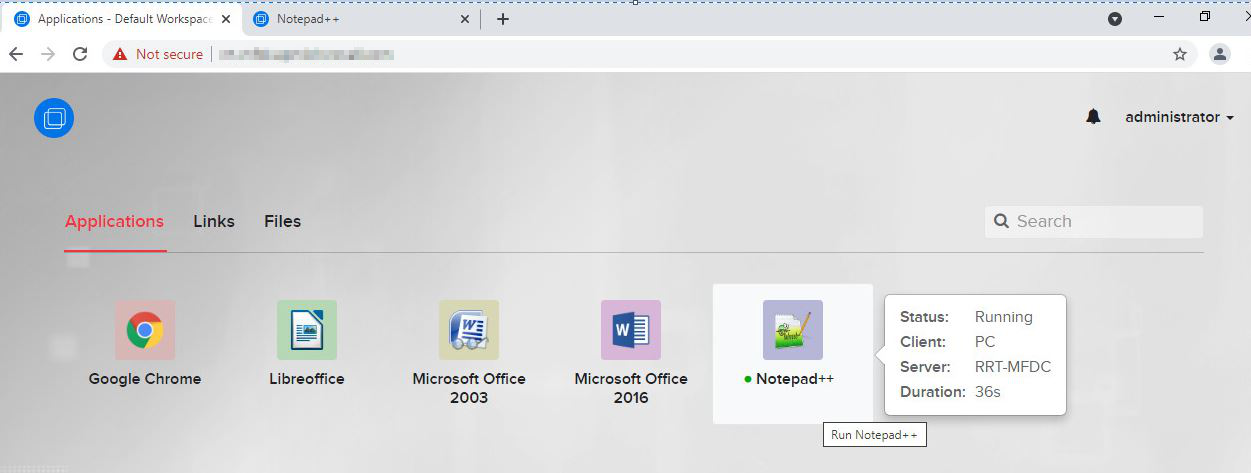
-
New! Mount Points application UI allows paths from the host to be mapped into paths inside application containers.
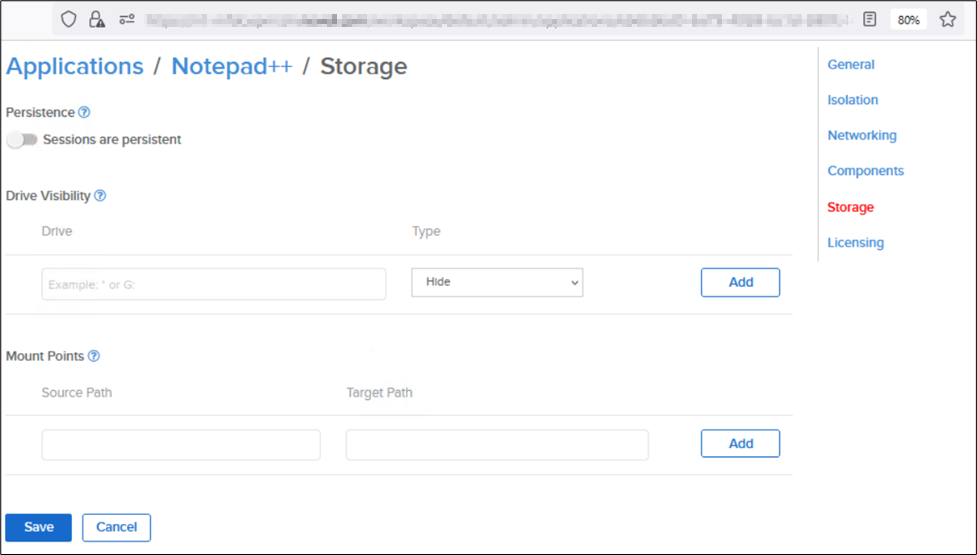
-
T: Drive now allows mounting of storage connections to specific paths within each storage provider connection. (Filr, Google Drive, DropBox, OneDrive)

-
Notifications allow administrators to notify groups of Turbo Server users with custom messages. Notifications are displayed to users on the Turbo Portal in the notifications dropdown.

-
Search is now available on the Portal Dashboard. Users can now quickly search Workspace contents by name.

-
Learning Management Systems (LMS) and Storage Provider integrations now allow for multiple connections.
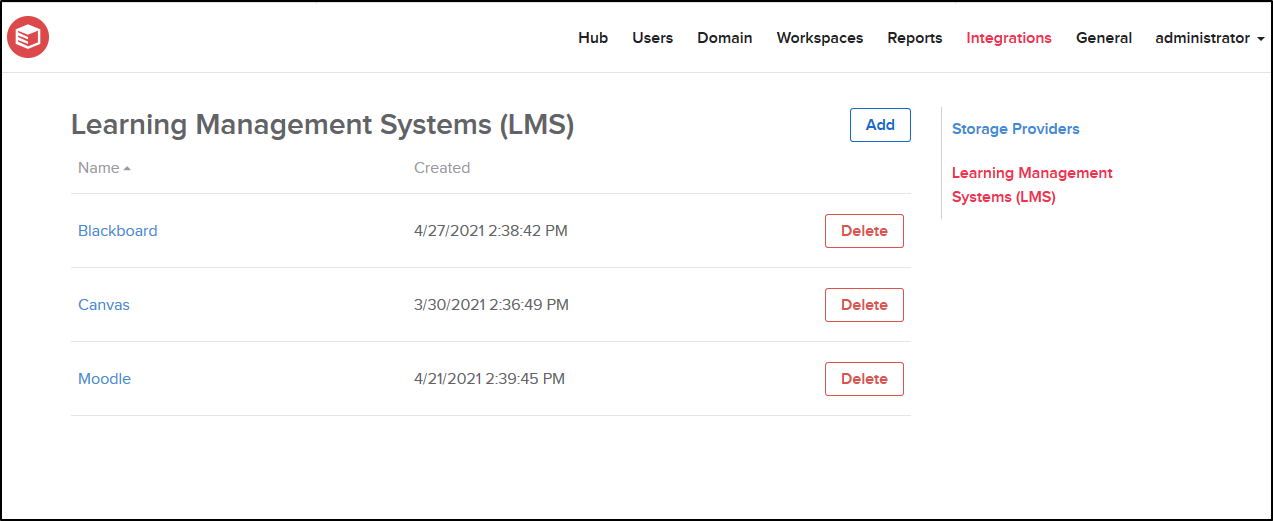
-
New! Workspace administration now gathers and displays additional launch analytics, including Type, Client, and Device.
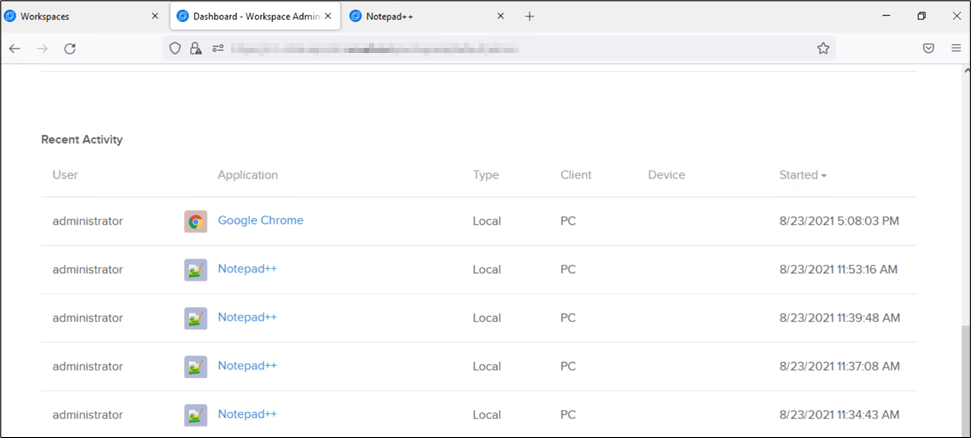
-
New Link Text, Workspace, and Automatically Create Channels settings provide control over presentation of Turbo link in LMSs, where the Turbo link will send the end user, and how the Turbo channel is initialized.
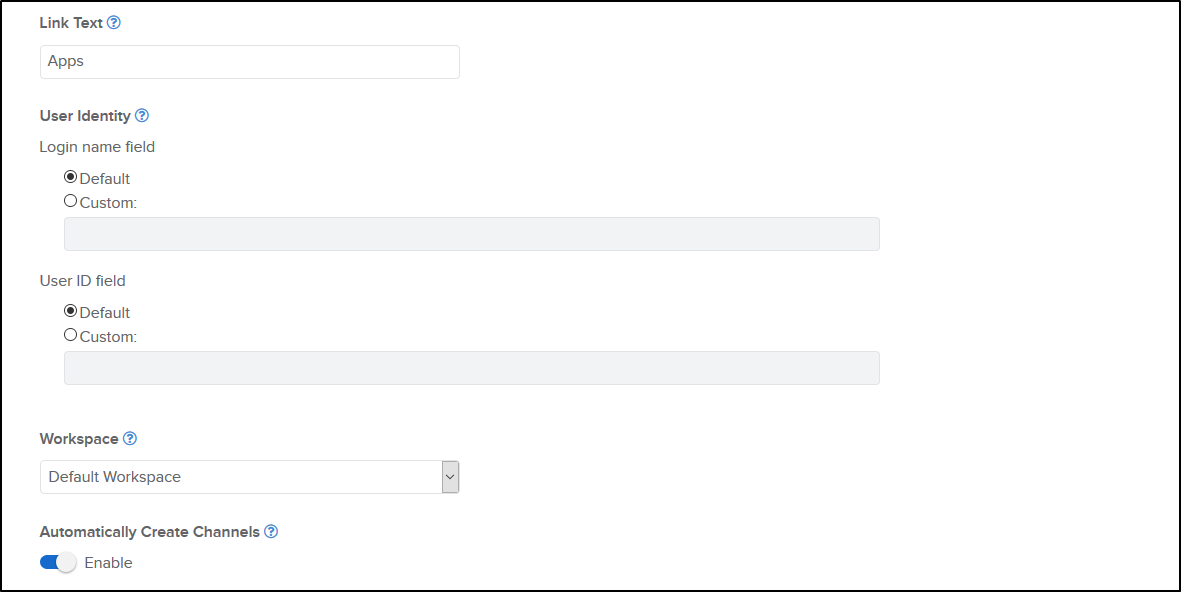
-
New Image Cleanup setting periodically cleans up cached application images from the Application Server.
-
New Application Image Path setting configures the path where images are stored on the Application Server.
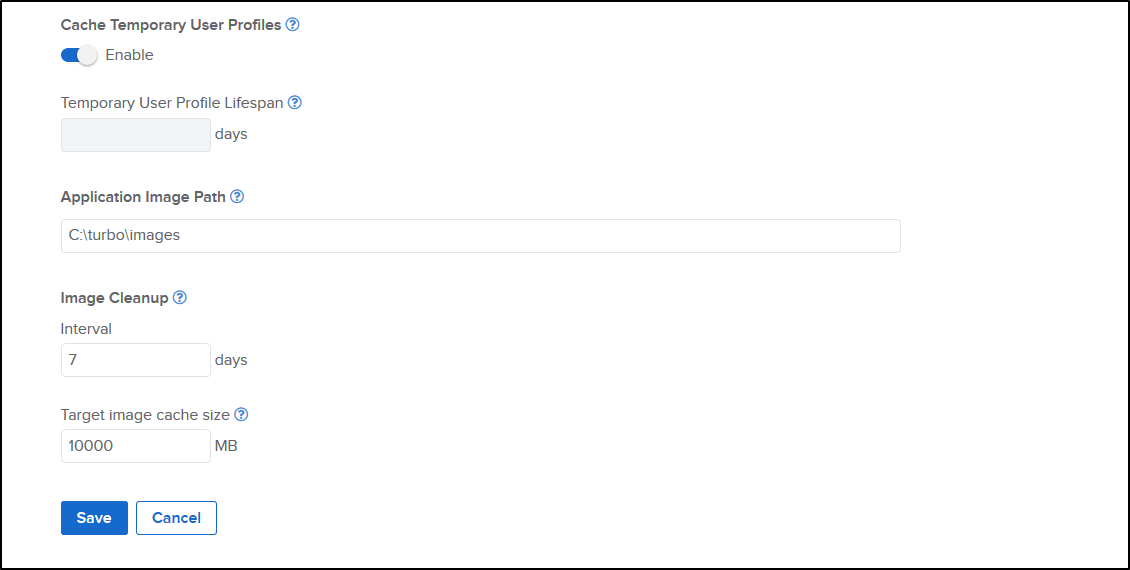
Other Improvements include:
-
The Micro Focus Desktop Containers Server is updated to version 21.7.3156.11.
-
Improved page load performance on Portal and Workspace administration sites.
-
Improved page load performance when a user belongs to a very large number of user groups.
-
SSO login errors now show additional troubleshooting information.
-
Workspace deletion will now offer an Undo action.
-
Improved date localization on the Server and Workspace administration sites.
-
Date range selection is now preserved when refreshing the Workspace analytics page.
-
Deleting a very large directory service now shows a warning message.
-
Improved dashboard dropdown and context menu display logic.
-
Updated various strings, logs, and administration site visuals.
-
New Automatically Grant Permissions option in the Learning Management System (LMS) integration allows automatically granting user level permissions to the configured workspace upon access.
-
Added User Management to the portal channel administration.
-
Improved portal channel administration navigation on mobile devices.
-
The HTML5 client now shows more accurate troubleshooting details if the Turbo Client was not installed correctly on the Application Server.
-
The Run in Cloud (Windowed) launch page text and troubleshooting details are now consistent with the HTML5 client.
-
Workspace applications are now be created with unique display names by default.
-
The workspace application Test actions are now enabled based on the application settings, application server settings, and application server availability.
-
The Dropbox integration has been updated to support upcoming Dropbox OAuth API changes.
-
Added a progress indicator to the Reset User Sandbox dialog and added the ability to delete user sandboxes.
-
Users are now removed from Single Sign-On (SSO) groups automatically during SSO login if they were removed in the external identity provider.
-
The Workspace Administration dashboard now has a custom date range selector with improved visualization of session launches.
-
Updated various strings and administration site visuals.
-
Deleting LMS connections and courses now offers to delete associated data
-
New HTTP Strict Transport Security setting enables the HSTS security header
-
Cloud launches now uses Write Copy isolation by default
-
The HTML5 client troubleshooting section now includes the error code and Server version
-
Workspace administration now uses locale-sensitive date formats
-
Removed static port requirements from Turbo Application Server services
-
The administration and API sites are now served from IIS Express, replacing the previous Apache server
-
Improved error handling when importing an invalid certificate during installation
-
Improved informational and error messages, along with improved logging
This update includes fixes for the following issues:
-
Hub database migrations can fail and result in a partial migration under certain circumstances.
-
Azure AD SSO logins do not automatically create all user groups if the user belongs to over 100 AD groups.
-
Disabling Cache Temporary User Profiles can result in application launch errors under certain circumstances.
-
Temporary users are not added to the Remote Desktop Users group in certain environments due to localization issues.
-
OCSP Stapling causes Turbo Server requests to hang in certain environments.
-
Custom Image Paths could result in permission errors when launching applications as a temporary profile user.
-
Automatically Grant Permissions does not grant channel permissions if the channel already existed.
-
Adding an SSO workspace permission does not automatically generate the SSO user group if a user group from a different directory service already existed with the same name.
-
Directory Service user and group counts were inaccurate for some service types.
-
HTML5 client audio was cutting out for certain applications.
-
Custom Image Path settings were not being applied for a short time after server upgrade.
-
The administration site would display an error on the first access after upgrade.
-
Deleting an LMS course resulted in an error.
-
The workspace link Open in New Window setting was not being applied properly on submission.
-
Automatically Create Channels setting no longer creates an unnecessary user permission for the channel administrator.
-
Quickly reconnecting to a disconnected session in the HTML5 client resulted in state detection issues.
-
Creating an API key with the same name as an existing user resulted in an error.
-
Dismissing the Turbo Server license warning incorrectly triggered form validation.
-
Some administration site delete confirmation dialogs failed to appear if the display name contained invalid characters.
-
Pushing images to a Turbo Hub via the Turbo Client could result in a certificate error
-
Native applications set the container name to base instead of the application name
-
Loading the Portal while logged into a recently deleted account shows an error page
-
Adding group permissions to a Workspace could fail if multiple groups exist with the same name
-
Certain applications were not listed in the Add Web Application browser selection
-
Temporary users were not fully removed from the server when Cache Temporary User Profiles was disabled
-
The Workspace administration dashboard Recent Activity table did not properly report the client type
-
Application installs failed for applications with certain display names
-
The Turbo Server installer did not import non-trusted certificates into the Windows certificate store
-
The Turbo Server installer could hang if the Turbo service failed to stop during installation
1.2 Micro Focus Desktop Containers Studio
This release includes fixes for the following issues:
-
The Micro Focus Desktop Containers Studio is updated to version 21.7.3156.11.
-
New! Turbo Studio Debugger log analysis tool.
-
Allow Startup Scripts to terminate the container with a non-zero exit code.
-
New virtual machine settings: Trim security elevation requirements from manifests, Enable AppLocker DLL rules compatibility, Enable FIPS compatibility, Enable process name isolation, Enable non-system drive isolation, Enable network share isolation, Enable DDE message isolation.
-
Support for loading fonts that are dynamically generated or in mounted folders.
-
Search results in filesystem or registry viewer not brought into view.
-
UI hang during long searches.
-
Filesystem and registry tree view very slow to scroll when containing many child nodes.
-
Error when building a configuration that was loaded from an imported image with a shim definition.
-
Inconsistency in Files path hierarchy whether imported or created new.
-
Disallow execution after date field not saved properly.
-
Fix for structured exception handling (SEH) during TLS initialization that caused a crash in Android Studio.
-
Fix for NtQueryObject not returning proper error codes for section and file object types that caused a crash in Autodesk Fusion 360.
-
Fixes an intermittent hang from processes, including some browsers, that suspend processes and threads for profiling and memory analysis
-
Fixes an intermittent hang caused by asynchronous operations on certain Merge isolated files
-
Fixes an issue with virtual COM objects that may be created in Office O365
-
Build & Run now uses turbo try to execute SVM project types
-
Build & Run and Run & Merge containers now use Write Copy isolation
-
Improved path validation for startup and shutdown scripts
-
Error messages that occur during builds could show up behind the Turbo Studio window
-
The application console was not inherited from the parent process even when requested
2.0 Product Documentation
The following sources provide information about Micro Focus Desktop Containers:
3.0 Understanding the Upgrade Requirements
-
All application configuration documents and application certificates created with ZENworks Application Virtualization 8.x, 9.x, 10.x, and 11.x must be re-created in order for application streams to work with the Micro Focus Desktop Containers standalone components.
To generate a new certificate and regenerate the configuration files:
-
In the Advanced section of the Micro Focus Desktop Containers Studio, click the App Config button to regenerate the application stream configuration files.
-
To generate a new site license certificate, click Advanced.
-
In the Application Certificates dialog box, click Request Certificate.
-
Specify the following information in the fields:
-
Organization: The organization name.
-
Unit: The user or unit name.
-
Allowed Portal Hosts: The allowed host names of the servers from which the application will stream.
-
-
Click Request to request the site license certificate, then save the certificate to a desired location.
-
Click the App Config button to regenerate the application stream configuration files again.
-
-
ZENworks Application Virtualization versions 8.x, 9.x, 10.x, 11.x and Micro Focus Desktop Containers 12.x always run side by side on a device. The Micro Focus Desktop Containers 12.x installation does not change the ZENworks Application Virtualization 8.x, 9.x or 10.x and 11.x installations in any way. However, if you open a virtual application and save it in version 12.x, it should not be subsequently used with version 8.x, 9.x 10.x or 11.x.
4.0 Legal Notices
For information about legal notices, trademarks, disclaimers, warranties, export and other use restrictions, U.S. Government rights, patent policy, and FIPS compliance, see https://www.novell.com/company/legal/.Copyright © 2021 Micro Focus Software Inc. All Rights Reserved.
Online Documentation: To access the latest online documentation for this and other Novell products, see the Novell Documentation Web page.